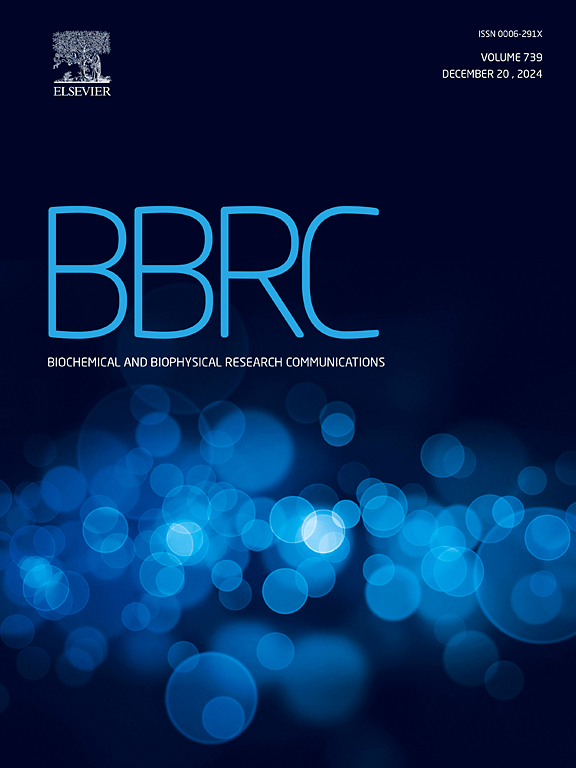Regulation of Notch signaling by miR-79 in Drosophila eye development
IF 2.2
3区 生物学
Q3 BIOCHEMISTRY & MOLECULAR BIOLOGY
Biochemical and biophysical research communications
Pub Date : 2025-06-21
DOI:10.1016/j.bbrc.2025.152222
引用次数: 0
Abstract
The Notch signaling pathway is crucial for cell fate determination and tissue morphogenesis. In Drosophila, Notch signaling regulates eye size, but the mechanisms that fine-tune its activity during eye development remain unclear. Here, we established a Notch-sensitized Drosophila model to identify novel regulators of this pathway. Using the Gal4/UAS system, we overexpressed fringe (fng) under ey-Gal4 control (ey > fng) in Drosophila eyes, disrupting Notch signaling and resulting in a small-eye phenotype. In this sensitizing background, a genetic screening identified miR-79 as a key modulator of Notch signaling. miR-79 overexpression rescued ey > fng-induced small-eye phenotype, whereas loss-of-function analysis using a mir-79 sponge exacerbated the phenotype, confirming its regulatory role. Furthermore, co-expression of miR-79 with the Notch ligands Delta or Serrate induced eye disc overgrowth near the equator, where Notch signaling is typically active, suggesting a strong genetic interaction between miR-79 and the Notch pathway. Functional studies revealed that miR-79 directly targets Beaded (Brd) by binding to specific Brd-Box motifs in its 3’ UTR. RNAi-mediated Brd knockdown phenocopied the rescue effect of miR-79 overexpression, whereas Brd gain-of-function enhanced the ey > fng phenotype. RNA in situ hybridization demonstrated complementary expression patterns of miR-79 and Brd during eye development. Although Tom, another Brd family member, was identified as a potential miR-79 target, luciferase assays confirmed that Tom is not directly regulated by miR-79. However, genetic interactions between Tom and Notch components suggest function redundancy with Brd. These findings establish miR-79 as a novel activator of Notch signaling in Drosophila eye development, primary through Brd regulation. This study provides new insights into molecular mechanisms governing Notch-mediated development and highlights the regulatory role of miR-79 in tissue growth and differentiation.
miR-79在果蝇眼发育中的Notch信号调控
Notch信号通路是决定细胞命运和组织形态发生的关键。在果蝇中,Notch信号调节眼睛的大小,但在眼睛发育过程中微调其活动的机制尚不清楚。在这里,我们建立了一个Notch-sensitized果蝇模型来识别这一途径的新调控因子。利用Gal4/UAS系统,我们在ey-Gal4控制下过表达条纹(fn) (ey >;在果蝇的眼睛中,破坏Notch信号并导致小眼睛表型。在这种敏感背景下,基因筛选鉴定出miR-79是Notch信号的关键调节剂。miR-79过表达拯救ey >;feng诱导的小眼表型,而使用mir-79海绵的功能丧失分析加剧了表型,证实了其调节作用。此外,miR-79与Notch配体Delta或Serrate的共表达诱导了赤道附近的眼盘过度生长,而赤道附近的Notch信号通常是活跃的,这表明miR-79与Notch通路之间存在很强的遗传相互作用。功能研究表明,miR-79通过结合其3 ' UTR中的特定Brd- box基序直接靶向串珠蛋白(Brd)。rnai介导的Brd敲低复制了miR-79过表达的拯救作用,而Brd的功能获得增强了小鼠的免疫功能。fng表现型。RNA原位杂交显示miR-79和Brd在眼睛发育过程中的互补表达模式。虽然另一个Brd家族成员Tom被确定为miR-79的潜在靶点,但荧光素酶测定证实Tom不受miR-79的直接调控。然而,Tom和Notch组分之间的遗传相互作用表明Brd具有功能冗余。这些发现证实了miR-79在果蝇眼睛发育过程中是Notch信号的新激活因子,主要通过Brd调控。这项研究为notch介导发育的分子机制提供了新的见解,并强调了miR-79在组织生长和分化中的调节作用。
本文章由计算机程序翻译,如有差异,请以英文原文为准。
求助全文
约1分钟内获得全文
求助全文
来源期刊
CiteScore
6.10
自引率
0.00%
发文量
1400
审稿时长
14 days
期刊介绍:
Biochemical and Biophysical Research Communications is the premier international journal devoted to the very rapid dissemination of timely and significant experimental results in diverse fields of biological research. The development of the "Breakthroughs and Views" section brings the minireview format to the journal, and issues often contain collections of special interest manuscripts. BBRC is published weekly (52 issues/year).Research Areas now include: Biochemistry; biophysics; cell biology; developmental biology; immunology
; molecular biology; neurobiology; plant biology and proteomics

 求助内容:
求助内容: 应助结果提醒方式:
应助结果提醒方式:


